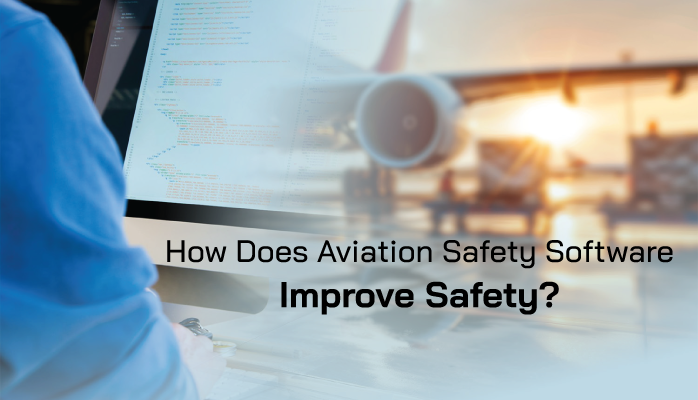Aviation Safety Software Prioritizes Safety

Aviation safety is the foundation of an industry where precision is critical, and the consequences of errors can be catastrophic.
Millions of passengers board flights daily, placing their trust in the systems and professionals ensuring their safety. To meet this responsibility, aviation safety software has become an indispensable tool, transforming how safety is managed worldwide.
These platforms enable proactive hazard identification,
real-time risk assessment, and compliance with stringent regulations, empowering safety managers to maintain the highest standards.
This comprehensive guide explores how aviation safety software enhances safety, supported by real-world examples, industry trends, and future developments, offering aviation safety managers actionable insights to strengthen their safety programs.
What is Aviation Safety Software?
Aviation safety software comprises digital tools that support Safety Management Systems (SMS), structured frameworks designed to manage safety risks in aviation organizations. An aviation SMS integrates policies, procedures, and practices to identify hazards, assess risks, and implement controls. Safety software acts as the digital backbone, streamlining these processes with features that enhance efficiency and accuracy.
Related Aviation Safety Software Articles
- How to Choose Aviation SMS Software - Educating SMS Professionals
- How to Choose the Best Aviation Safety Database Software
- 20 Benefits of Aviation SMS Software
Key Features of Aviation Safety Software
The following table outlines the core functionalities of aviation safety software and their contributions to safety management:
|
Feature |
Description |
|---|---|
|
Hazard Identification |
Facilitates easy reporting of safety concerns through intuitive interfaces. |
|
Risk Assessment |
Provides tools to evaluate risk severity and likelihood, guiding mitigation. |
|
Incident Tracking |
Monitors incidents and near-misses, enabling thorough root cause analysis. |
|
Compliance Management |
Tracks regulatory requirements and manages audits for consistent compliance. |
|
Data Analytics |
Analyzes safety data to identify trends and support informed decision-making. |
|
Training Management |
Manages training requirements and tracks employee competencies. |
|
Document Management |
Centralizes safety documents for easy access, updates, and version control. |
|
Safety Communications |
Facilitates safety surveys, newsletters, read & sign files, safety meetings. |
|
Performance Monitoring |
Offers real time dashboards, SPI tracking, automated alerts. |
These features create a cohesive platform, allowing organizations to manage safety holistically. For example, SMS Pro digitizes audit and security checklists and optimizes incident reporting using mobile apps or a Web interface.
The Evolution of Aviation Safety Software
The development of aviation safety software began in the early 2000s, driven by the need to digitize safety management processes. Early systems focused on basic incident reporting and risk assessment, often replacing cumbersome paper-based methods. As technology advanced, these platforms evolved to include sophisticated features like predictive analytics, real-time data integration, and mobile accessibility. This transformation reflects the industry’s growing complexity and the demand for data-driven safety solutions.
Today, companies like SMS Pro lead the market, offering solutions that not only meet regulatory requirements but also enhance operational efficiency and safety culture. The shift to digital platforms has accelerated reporting, improved data accuracy, and enabled faster responses to potential hazards, marking a significant leap from the manual systems of the past.
Related Articles on Aviation Safety Software Benefits
- 21 Benefits of Risk Management Software for Aviation SMS
- 6 Benefits of Cloud-Based Aviation SMS Data Strategy
- 43 Benefits of Aviation Safety Management Systems (Proven)
How Aviation Safety Software Improves Safety
Aviation safety software enhances safety through multiple mechanisms, each addressing critical aspects of safety management.
Proactive Hazard Identification and Reporting
Proactive hazard identification is central to effective safety management. Aviation safety software simplifies reporting with user-friendly, often mobile-accessible interfaces, encouraging employees to report concerns promptly. This accessibility has led to significant increases in reporting rates.
For instance, an airline's adoption of SMS Pro resulted in a 60% surge in incident reporting, enhancing risk awareness and yielding substantial insurance savings. Anonymous reporting options further boost participation by alleviating fears of repercussions, improving both the quantity and quality of reports. The data collected enables trend analysis, allowing managers to address systemic issues before they escalate into accidents.
Related Articles on Aviation Hazard Reporting
- Indicators of Good Hazard Reporting Culture
- How Safety Managers Hurt Their Aviation Hazard Reporting Processes
- What Is Missing Most in Aviation Hazard Reporting Systems?
Real-Time Data and Analytics
Timely information is vital in aviation. Safety software aggregates data in real-time from sources like flight data recorders and employee reports, providing immediate insights into safety performance. Advanced analytics identify patterns, such as recurring maintenance issues, enabling swift action. Predictive analytics, integrated into platforms like SMS Pro, forecast potential hazard events, shifting safety management from reactive to proactive.
Enhanced Regulatory Compliance
Aviation operates under strict regulations from bodies like the FAA (FAA SMS) and ICAO. Non-compliance can result in penalties or operational restrictions. Safety software automates compliance tracking, schedules audits, and maintains documentation, reducing risks. SMS Pro's risk management platform, for example, ensures consistent monitoring of operational risks.
Related Articles on Aviation SMS Audits
- Real Difference Between an Aviation Safety Audit vs. Inspection
- How to Conduct Internal SMS Audits in Aviation Industry
- 5 Ways to Prepare for Aviation SMS Audits
Fostering a Positive Safety Culture
A strong safety culture promotes open communication and shared responsibility. Software supports this by offering anonymous reporting and automated, transparent feedback mechanisms, thereby building trust among employees. Modern safety reporting systems with user-friendly intuitive designs increases safety reporting metrics, reinforcing a culture prioritizing safety.
Efficient Incident Investigation
Thorough incident investigations are crucial for preventing recurrence. Safety software streamlines this process with structured workflows and data integration, facilitating comprehensive root cause analysis. SMS Pro’s Safety Case Manager module, for instance, supports detailed incident documentation, ensuring lessons are effectively applied.
Improved Training and Competency
Human error remains a significant risk in aviation. Safety software tracks training needs, schedules sessions, and maintains competency records, ensuring staff are well-prepared. This is particularly critical for maintenance teams, where platforms like SMS Pro ensure adherence to standardized procedures.
Trends in Aviation Safety
The aviation industry has made significant strides in safety, as evidenced by Boeing’s Annual Summary of Commercial Jet Airplane Accidents (Boeing Stats). From 1959 to 2024, there were 2,183 total accidents, with 641 fatal, resulting in 30,301 onboard fatalities. However, recent decades show marked improvement. Between 2005–2014 and 2015–2024, the accident rate declined by 40%, hull loss rate by 55%, and fatal accident rate by 65%. Total accidents dropped by 25%, hull losses by 45%, and fatal accidents by 55%.
These improvements stem from advancements in technology, training, and risk management, with safety software playing a pivotal role. By enabling proactive hazard identification, real-time analytics, and data-driven decisions, software contributes to the industry’s ongoing safety enhancements.
Related Articles on Proactive Risk Management
- Difference Between Reactive, Predictive and Proactive Risk Management
- Checklist for Proactive Safety Culture in Aviation SMS Programs [With Free Resources]
- 3 Things Hurting Your Proactive Risk Management in Aviation SMS
Current Trends and Future Developments
The aviation safety software landscape is evolving, driven by technological and regulatory advancements.
Artificial Intelligence and Machine Learning
AI and machine learning are revolutionizing safety management by enabling predictive analytics. These technologies analyze vast datasets to identify patterns and predict risks, such as equipment failures, allowing preemptive action.
Data Sharing and Collaboration
Initiatives like the Aviation Safety Information Analysis and Sharing (ASIAS) program promote data sharing among stakeholders. Software platforms facilitate secure, de-identified data exchange, enhancing collective safety insights.
Regulatory Evolution
Regulatory bodies are expanding SMS requirements, with the FAA adopting SMS across its operations. Software must adapt to ensure compliance with evolving standards.
Mobile and Cloud Technologies
Mobile and cloud-based solutions enhance accessibility, allowing hazard reporting from anywhere. Cloud platforms ensure data security and remote access, critical for multi-site operations.
Integration with Other Systems
Future software will integrate with maintenance, flight operations, and other systems, providing a holistic safety view, improving coordination, and reducing risks.
Challenges and Considerations
Despite its benefits, aviation safety software faces challenges:
-
User Adoption: Resistance to new systems can limit effectiveness, requiring robust training programs.
-
Integration: Compatibility with existing systems is essential for seamless operation.
-
Cost: Implementation and training involve upfront costs, though long-term savings often justify the investment.
Addressing these through stakeholder engagement and strategic planning is critical for success.
Conclusion
Aviation safety software is a cornerstone of modern safety management, offering tools for
- proactive hazard identification,
- real-time analytics,
- compliance, and
- cultural enhancement.
Case studies from demonstrate tangible benefits, including
- increased reporting,
- strengthened safety cultures,
- improved efficiency, and
- enhanced safety outcomes.
With accident rates declining significantly—40% from 2005–2024—software plays a vital role in the industry’s safety progress. As AI, data sharing, and regulatory advancements shape the future, aviation safety managers must leverage these tools to maintain and elevate safety standards, ensuring air travel remains the safest mode of transportation.
Last updated May 2025.







